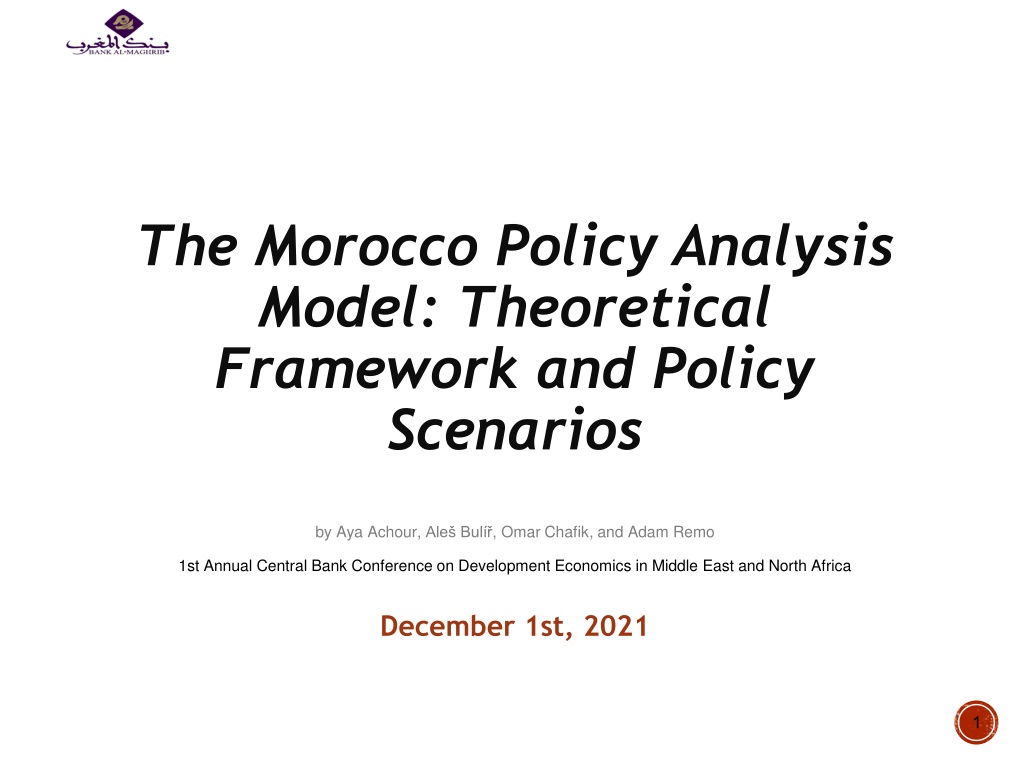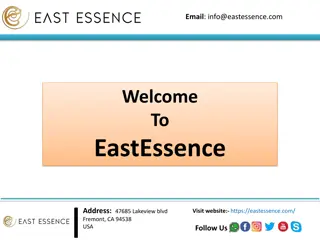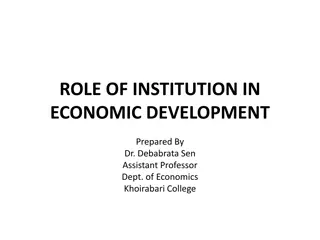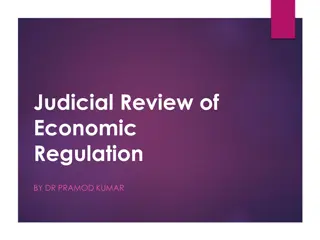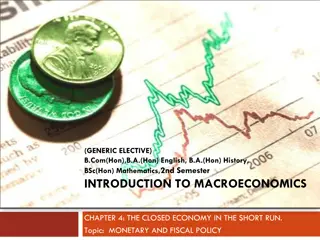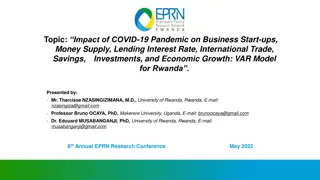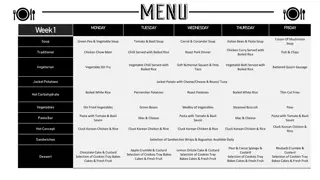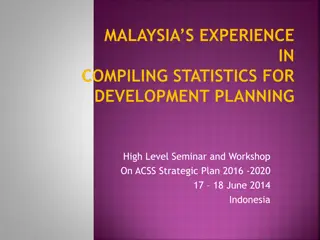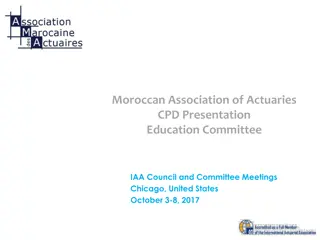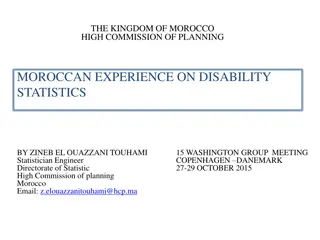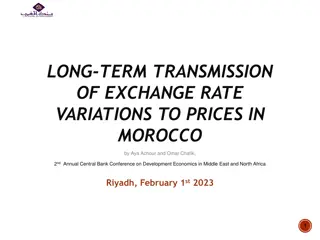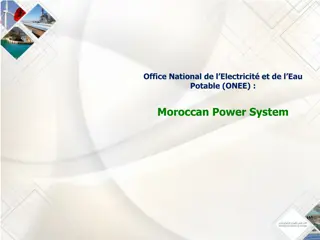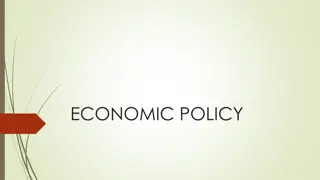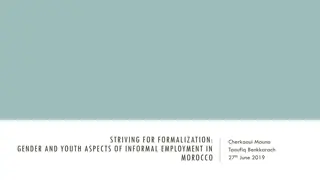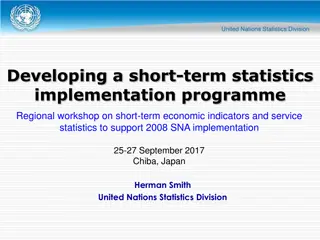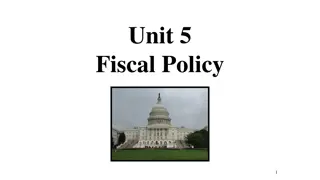Analysis of the Moroccan Policy Analysis Model for Economic Development
The Morocco Policy Analysis Model (MOPAM) is a large-scale annual model that incorporates fiscal and monetary policies, inspired by the IMF's FSGM model. It examines the impact of a flexible exchange rate regime and various fiscal policy stances on economic fundamentals. MOPAM features DSGE and OLG-style models to analyze long- and short-run effects and behavioral changes in response to structural reforms in Morocco.
- Moroccan Policy Analysis Model
- Economic Development
- Fiscal Policy
- Monetary Policy
- Macroeconomic Resilience
Download Presentation

Please find below an Image/Link to download the presentation.
The content on the website is provided AS IS for your information and personal use only. It may not be sold, licensed, or shared on other websites without obtaining consent from the author. Download presentation by click this link. If you encounter any issues during the download, it is possible that the publisher has removed the file from their server.
E N D
Presentation Transcript
The Morocco Policy Analysis Model: Theoretical Framework and Policy Scenarios by Aya Achour, Ale Bul , Omar Chafik, and Adam Remo 1st Annual Central Bank Conference on Development Economics in Middle East and North Africa December 1st, 2021 1
Context and motivations In January 15th2018, Moroccan s authorities launched the reform for a more flexible exchange rate regime Since the beginning, the transition is stated to be voluntary, ordered and gradual over time. Engaging the reform s next phase is subjected to the fulfillment of a number of pre- conditions, among them sound fiscal policy, adequate FX reserves level, preparedness of involved actors, etc. Prior and during the reform, Central Bank of Morocco (BAM) must address complex issues related to macroeconomic resilience: Assessing the impact of a flexible exchange rate regime on key macro variables and shocks transmission mechanisms within this framework Studying the impact of different fiscal policy stance on reform s stages implementation Identifying the implications of structural reforms (subsidies removal, capital account openness, etc.) on economic fundamentals, in particular real exchange rate. 2 13/08/2024
Context and motivations To handle these topics consistently, BAM has identified as prerequisite the enhancement of its modeling and forecasting capacities. What is the Morracan Policy Analysis Model (MOPAM)? A large-scale annual model inspired by the FSGM-model developed by the IMF Research Department (Andrle et al.(2015)) The model itself is a mix of traditional dynamic stochastic general equilibrium (DSGE) segments and ad hoc data-driven segments State-of-the-art benchmark model for policy analysis What does it do? Incorporates the fiscal and monetary policy in a consistent framework: Monetary policy: DSGE-style model with nominal and real rigidities Fiscal policy: OLG-style model with non-Ricardian features Examines long- and short-run effects of fiscal policy choices Considers behavioral changes in response to structural reforms in a shock minus control fashion 3 13/08/2024
Structure of MOPAM and features of the Moroccan economy Large scale DSGE like model where private consumption and investment are micro-founded. Trade, labor supply, and inflation have reduced-form theoretical representations. Aggregate supply is determined by a Cobb Douglas production technology (Capital, Labor and Total Factor Productivity (TFP)). Aggregate demand is encapsulated by the national income identity. Core CPI is driven by aggregate demand and aggregate supply interactions. The MOPAM introduces important non-Ricardian properties so that the level and path of government debt have significant economic implications. Liquidity-constrained (or hand-to-mouth) households Overlapping Generations Households implying some degree of myopia (Blanchard (1985) and Yaari (1965)) Distortionary taxes on labor and capital to further relax Ricardian equivalence 4 13/08/2024
Structure of MOPAM and features of the Moroccan economy Monetary and fiscal policy are endogenous - pinned down by policy reaction functions. Central bank s monetary policy is described by a combination of interest rate and exchange rate policy rules in the environment of limited currency convertibility. Although the model is not primarily aimed at business cycle analysis, nominal rigidities are the main feature to insure the transmission of monetary policy in the short run. Fiscal policies can be implemented in the model in flexible and consistent way. Government can use different fiscal rules (deficit/debt targeting) using a diverse set of fiscal instruments (distortionary taxes, current and capital expenditures). MOPAM is calibrated so as to replicate the key accounting ratios and captures the main features of the Moroccan economy (agriculture sector, Phosphate sector, price subsidies, monetary and exchange rate regimes, etc.). 5 13/08/2024
Medium term economic scenarios for Morocco To demonstrate the richness and flexibility of the MOPAM framework, we use two counterfactual medium-term policy scenarios: A multipronged fiscal consolidation strategy which builds on the government commitments listed in the pre-Covid IMF-supported PLL arrangement and the 2019 National Conference on Taxation A harsh reality scenario which reflects the impact of the COVID-19 pandemic on Morocco and some of the government s policy choices based on a set of at home and abroad assumptions The steady state or control in our simulations corresponds to an unchanged policy scenario. The simulation results of these counterfactual scenarios are based on a set of assumptions and expert judgments. Hence, they should not be interpreted as either Bank Al-Maghrib or IMF forecasts. 1. 2. 6 13/08/2024
a. Fiscal consolidation and tax reforms under PLL: insights from MOPAM Scenario description Decrease government debt from 65% of GDP to 60% over 5 years Government expenditure Government revenue MOPAM - Increase the average effective rate of VAT by removing reduced rates and exemptions. some - Stabilize the wage bill. - Remove gas subsidies. - Reduce Income Tax rate by adopting a progressive regime. the effective Capital - Increase public investment. -This scenario captures the Government s fiscal consolidation commitments under the PLL starting from 2020. -It remains counterfactual since it assumes that the COVID-19 pandemic did not occur. Any budget consolidation plan formulated before the pandemic would have to be reassessed once the pandemic is under control. 8/13/2024 7
a. Fiscal consolidation and tax reforms under PLL: insights from MOPAM Short-term cost vs long- term gain Fiscal consolidation has a slightly negative impact on real GDP during 2020-2025. Public deficits decline, financed by permanently higher temporary cuts in expenditures, most importantly a lower (Simulation 1; blue line) and higher indirect taxes (Simulation 2; red line), with the income tax changes having a negligible impact (Simulation 3; yellow line). The trade-off authorities: Real GDP bottoms out at -0.7 pp in 2022 against a cumulative gain of about 7% of real GDP in present value terms in long- term revenue and wage bill facing Morrocan 8 8/13/2024
a. Fiscal consolidation and tax reforms under PLL: insights from MOPAM Public indebtedness, tax reforms and efficiency gains The reduction in public indebtedness and a relative switch from direct to indirect taxes are expected to generate efficiency gains and lead to a substantial increase in private investment. However, remaining negatively the growth in medium term through lower private Although it is compensated by higher public investment and targeted social transfers that drove permanently the GDP above the level. the fuel gradual subsidies removal of impacts investment. 9 8/13/2024
a. Fiscal consolidation and tax reforms under PLL: insights from MOPAM Limited room for maneuver for the Central Bank The impact of this consolidation on prices and monetary policy is limited, partly due to the current exchange rate regime, which limits the Central Bank s room for manouvre. Overall, the results suggest that the parameter of the fiscal consolidation alongside the tax reforms can be considered as key instrument for more inclusive growth in Morocco. 10 8/13/2024
b. Economic impact of Covid-19 pandemic in Morocco: insights from MOPAM Scenario description - Contraction in partners economies (US, EU) Decrease in imported inflation Monetary easing in advanced economies Major drop in tourism Decline in remittances - Drop in international commodity prices (oil, phosphates, food) - - - - Exernal sector Commodity markets Domestic shocks MOPAM - - Fiscal expansion Increase in cash transfers to households (unemployment compensation, transfers to poor households, etc.) Increase in health spending Cut most of nonurgent public investment Higher fiscal deficit and public debt Increase in import tariffs on selected imports - Under capacities resulting from the months lockdown Decline in labor supply Surge in investor and consumers uncertainty Hike in risk premiums (government, investment, retail) Increase in the unemployment rate utilization of production Fiscal measures 3 - - - - - - - - - The scenario excluded from the initial conditions and near-term forecasts other events that were not related to the pandemic (below-average harvest) - The content of the initial conditions is limited to information available until June 2020 11 8/13/2024
b. Economic impact of Covid-19 pandemic in Morocco: insights from MOPAM Fiscal stimulus: Limiting the short term impact on GDP or preserving long term private investment? The Covid-19 crisis is expected to result in a drop of GDP of about -10 pp in 2020 without fiscal measures. The fiscal package helps to limit GDP drop to -6 pp in 2020 relative to the baseline. The Covid-19 pandemic will lead to a demand shortfalls as well as medium- term supply-side disruptions that would hold down potential GDP growth for some time. Uncertainty about the long-lasting effect of the pandemic: slow recovery in trading partner commodity markets. countries and Without monetary policy interest rate would have to fall near the zero lower bound, in response to the disinflationary pressures. the fiscal expansion, the 12 8/13/2024
b. Economic impact of Covid-19 pandemic in Morocco: insights from MOPAM The Morocco s policy-mix to help mitigate the impact of the pandemic The policy-mix implemented by the Moroccan authorities helped mitigate the pandemic on growth, FX reserves, and exchange rate depreciation. impact of the The slightly weaker dirham should remain within the fluctuation band of 5%, supported by forex interventions, the catalytic effect of PLL purchase, and an increase in import tariffs. 13 8/13/2024
Conclusion We described in our paper an approach to simulating macroeconomic variables using MOPAM, a large-scale macroeconomic, semi-structural model developed at Bank Al- Maghrib Two recent scenarios of interest for the decision makers were addressed (fiscal consolidation and tax reforms pre-Covid-19 crisis in 2019 and the impact of the Covid-19 outbreak in 2020). The structure of the MOPAM allows us to emphasize in each scenario the cost/benefit trade-offs in the short and long run. It also helps us to study the monetary-fiscal policy mix (e.g., the case of the Covid-19 simulation) and its implication for Morocco. We demonstrated that a large scale semi-structural model can be readily adapted to changes in the fiscal, monetary and exchange rate regimes. Its adaptability proved its worth in a transitioning country even in assessing large simultaneous economic shocks such as the sanitary crisis. 14 13/08/2024
THANK YOU FOR YOUR ATTENTION 15 13/08/2024
